The Theory Of Helicopter Flight
-
Introduction:
Even though the design of the modern helicopter was not perfected until the late 1930s, it is arguably one of the earliest ideas for achieving flight, predating the concept of the glider by perhaps as much as two thousand years. Inspired by the flight of birds, even ancient humans dreampt of soaring at high speeds, stopping on a dime, and hovering in place, much like a hummingbird or dragonfly. Yet no one truly appreciated the complexities needed to make that dream become reality, and it took the collected wisdom and patience of a number of notable aviation pioneers over the course of centuries to bring that technology into existence.
Airfoils
A helicopter flies for the same basic reason that any conventional aircraft flies, because aerodynamic forces necessary to keep it aloft are produced when air passes about the rotor blades. The rotor blade, or airfoil, is the structure that makes flight possible. Its shape produces lift when it passes through the air. Helicopter blades have airfoil sections designed for a specific set of flight characteristics. Usually the designer must compromise to obtain an airfoil section that has the best flight characteristics for the mission the aircraft will perform.
Airfoil sections are of two basic types, symmetrical and nonsymmetrical. Symmetrical airfoils have identical upper and lower surfaces. They are suited to rotary-wing applications because they have almost no center of pressure travel. Travel remains relatively constant under varying angles of attack, affording the best lift-drag ratios for the full range of velocities from rotor blade root to tip. However, the symmetrical airfoil produces less lift than a nonsymmetrical airfoil and also has relatively undesirable stall characteristics. The helicopter blade must adapt to a wide range of airspeeds and angles of attack during each revolution of the rotor. The symmetrical airfoil delivers acceptable performance under those alternating conditions. Other benefits are lower cost and ease of construction as compared to the nonsymmetrical airfoil.
Nonsymmetrical (cambered) airfoils may have a wide variety of upper and lower surface designs. They are currently used on some CH-47 and all OH-58 Army helicopters, and are increasingly being used on newly designed aircraft. Advantages of the nonsymmetrical airfoil are increased lift-drag ratios and more desirable stall characteristics. Nonsymmetrical airfoils were not used in earlier helicopters because the center of pressure location moved too much when angle of attack was changed. When center of pressure moves, a twisting force is exerted on the rotor blades. Rotor system components had to be designed that would withstand the twisting force. Recent design processes and new materials used to manufacture rotor systems have partially overcome the problems associated with use of nonsymmetrical airfoils.
Airfoil Sections
Rotary-wing airfoils operate under diverse conditions, because their speeds are a combination of blade rotation and forward movement of the helicopter. An intelligent discussion of the factors affecting the magnitude of rotor blade lift and drag requires a knowledge of blade section geometry. Blades are designed with specific geometry that adapts them to the varying conditions of flight. Cross-section shapes of most rotor blades are not the same throughout the span. Shapes are varied along the blade radius to take advantage of the particular airspeed range experienced at each point on the blade, and to help balance the load between the root and tip. The blade may be built with a twist, so an airfoil section near the root has a larger pitch angle than a section near the tip.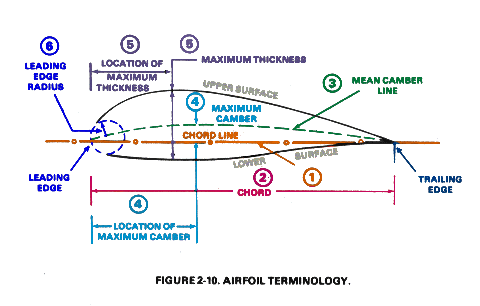
-The chord line is a straight line connecting the leading and trailing edges of the airfoil.
-The chord is the length of the chord line from leading edge to trailing edge and is the characteristic longitudinal dimension of the airfoil.
-The mean camber line is a line drawn halfway between the upper and lower surfaces. The chord line connects the ends of the mean camber line.
-The shape of the mean camber is important in determining the aerodynamic characteristics of an airfoil section. Maximum camber (displacement of the mean camber line from the chord line) and the location of maximum camber help to define the shape of the mean camber line. These quantities are expressed as fractions or percentages of the basic chord dimension.
-Thickness and thickness distribution of the profile are important properties of an airfoil section. The maximum thickness and its location help define the airfoil shape and are expressed as a percentage of the chord.
-The leading edge radius of the airfoil is the radius of curvature given the leading edge shape. -
Main Rotor Design
There are almost as many designs for helicopter main rotors as there are different models of helicopter. Still, there are several main classes of main rotor. Generally, the major classification is by the type of rotor head used. The most common are:
- Rigid
- Semi-Rigid
- Fully Articulated
Rotary Wing Platform
Common terms used to describe the helicopter rotor system are shown here. Although there is some variation in systems between different aircraft, the terms shown are generally accepted by most manufacturers. The system shown here is fully articulated: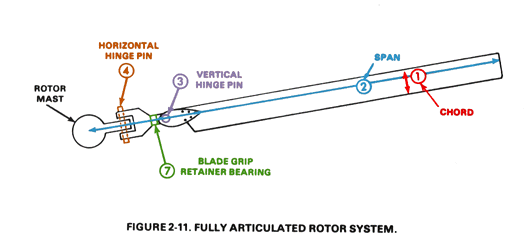

Above are articulated rotors
Semirigid types do not have a vertical or horizontal hinge pin. Instead, the rotor is allowed to teeter or flap by a trunnion bearing that connects the yoke to the mast: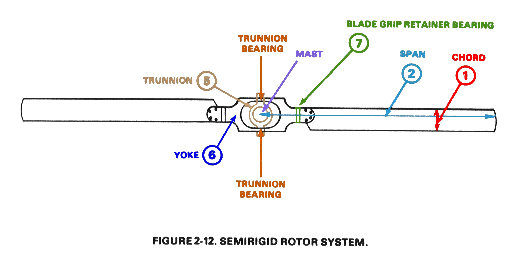
- The chord is the longitudinal dimension of an airfoil section, measured from the leading edge to the trailing edge.
- The span is the length of the rotor blade from the point of rotation to the tip of the blade.
- The vertical hinge pin (drag hinge) is the axis which permits fore and aft blade movement independent of the other blades in the system.
- The horizontal hinge pin is the axis which permits up and down movement of the blade independent of the other blades in the system.
- The trunnion is splined to the mast and has two bearings through which it is secured to the yoke. The blades are mounted to the yoke and are free to teeter (flap) around the trunnion bearings.
- The yoke is the structural member to which the blades are attached and which fastens the rotor blades to the mast through the trunnion and trunnion bearings.
- The blade grip retainer bearing is the bearing which permits rotation of the blade about its spanwise axis so blade pitch can be changed (blade feathering)
- Blade Twist is a characteristic built into the rotor blade so angle of incidence is less near the tip than at the root. Blade twist helps distribute the lift evenly along the blade by an increased angle of incidence near the root where blade speed is slower. Outboard portions of the blade that travel faster normally have lower angles of incidence, so less lift is concentrated near the blade tip. -
Err.... How helicopter fly huh?
-
Centrifugal Force
Helicopter rotor systems depend primarily on rotation to produce relative wind which develops the aerodynamic force required for flight. Because of its rotation and weight, the rotor system is subject to forces and moments peculiar to all rotating masses. One of the forces produced is centrifugal force. It is defined as the force that tends to make rotating bodies move away from the center of rotation. Another force produced in the rotor system is centripetal force. It is the force that counteracts centrifugal force by keeping an object a certain radius from the axis of rotation.
The rotating blades of a helicopter produce very high centrifugal loads on the rotor head and blade attachement assemblies. As a matter of interest, centrifugal loads may be from 6 to 12 tons at the blade root of two to four passenger helicopters. Larger helicopters may develop up to 40 tons of centrifugal load on each blade root. In rotary-wing aircraft, centrifugal force is the dominant force affecting the rotor system. All other forces act to modify this force.
When the rotor blades are at rest, they droop due to their weight and span. In fully articulated systems, they rest against a static or droop stop which prevents the blade from descending so low it will strike the aircraft (or ground!). When the rotor system begins to turn, the blade starts to rise from the static position because of the centrifugal force. At operating speed, the blades extend straight out even though they are at flat pitch and are not producing lift.
As the helicopter develops lift during takeoff and flight, the blades rise above the "straight out" position and assume a coned position. Amount of coning depends on RPM, gross weight, and G-Forces experienced during flight. If RPM is held constant, coning increases as gross weight and G-force increase. If gross weight and G-forces are constant, decreasing RPM will cause increased coning. Excessive coning can occur if RPM gets too low, gross weight is too high, or if excessive G-forces are experienced. Excessive coning can cause undesirable stresses on the blade and a decrease of total lift because of a decrease in effective disk area:
Notice that the effective diameter of the rotor disk with increased coning is less than the diameter of the other disk with less coning. A smaller disk diameter has less potential to produce lift.
Centrifugal force and lift effects on the blade can be illustrated best by a vector. First look at a rotor shaft and blade just rotating: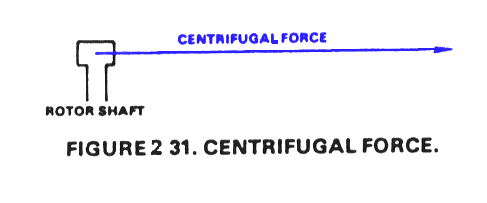
Now look at the same rotor shaft and blade when a vertical force is pushing up on the tip of the blade:
The vertical force is lift produced when the blades assume a positive angle of attack. The horizontal force is caused by the centrifugal force due to rotation. Since one end of the blade is attached to the rotor shaft, it is not free to move. The other end can move and will assume a position that is the resultant of the forces acting on it: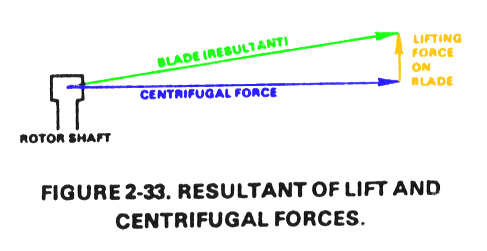
The blade position is coned and is a resultant of the two forces, lift and centrifugal force, acting on it. -
Hovering
Hovering is the term applied when a helicopter maintains a constant position at a selected point, usually a few feet above the ground (but not always, helicopters can hover high in the air, given sufficient power). For a helicopter to hover, the main rotor must supply lift equal to the total weight of the helicopter. With the blades rotating at high velocity, an increase of blade pitch (angle of attack) would induce the necessary lift for a hover. The forces of lift and weight reach a state of balance during a stationary hover.
Hovering is actually an element of vertical flight. Assuming a no-wind condition, the tip-path plane of the blades will remain horizontal. If the angle of attack of the blades is increased while their velocity remains constant, additional vertical thrust is obtained. Thus, by upsetting the vertical balance of forces, helicopters can climb or descend vertically.
Airflow during hovering
At a hover, the rotor tip vortex (air swirl at the tip of the rotor blades) reduces the effectiveness of the outer blade portions. Also, the vortexes of the preceding blade severely affect the lift of the following blades. If the vortex made by one passing blade remains a vicious swirl for some number of seconds, then two blades operating at 350 RPM create 700 longlasting vortex patterns per minute. This continuous creation of new vortexes and ingestion of existing vortexes is a primary cause of high power requirements for hovering.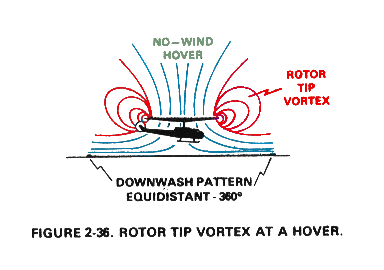
During hover, the rotor blades move large volumes of air in a downward direction. This pumping process uses lots of horsepower and accelerates the air to relatively high velocities. Air velocity under the helicopter may reach 60 to 100 knots, depending on the size of the rotor and the gross weight of the helicopter. The air flow pattern of a hovering helicopter is illustrated here: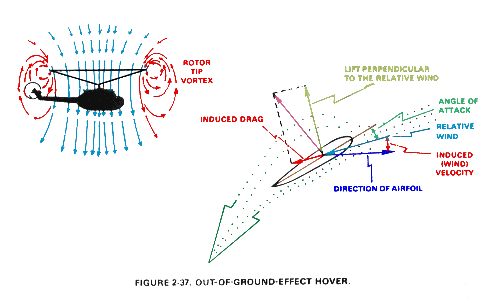
Note how the downwash (induced flow) of air has introduced another element into the relative wind which alters the angle of attack of the airfoil. When there is no induced flow, the relative wind is opposite and parallel to the flightpath of the airfoil. In the hovering case, the downward airflow alters the relative wind and changes the angle of attack so less aerodynamic force is produced. This condition requires the pilot to increase collective pitch to produce enough aerodynamic force to sustain a hover. Although this does increase the lift, it also increases the induced drag, and so total power required is higher. -
Ground effect
The high power requirement needed to hover out of ground effect is reduced when operating in ground effect. Ground effect is a condition of improved performance encountered when operating near (within 1/2 rotor diameter) of the ground. It is due to the interference of the surface with the airflow pattern of the rotor system, and it is more pronounced the nearer the ground is approached. Increased blade efficiency while operating in ground effect is due to two separate and distinct phenomena.
First and most important is the reduction of the velocity of the induced airflow. Since the ground interrupts the airflow under the helicopter, the entire flow is altered. This reduces downward velocity of the induced flow. The result is less induced drag and a more vertical lift vector. The lift needed to sustain a hover can be produced with a reduced angle of attack and less power because of the more vertical lift vector: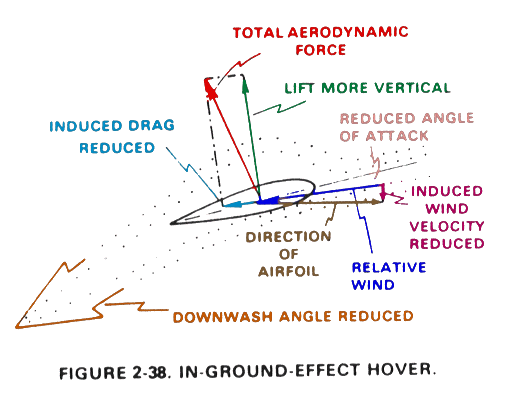
The second phenomena is a reduction of the rotor tip vortex: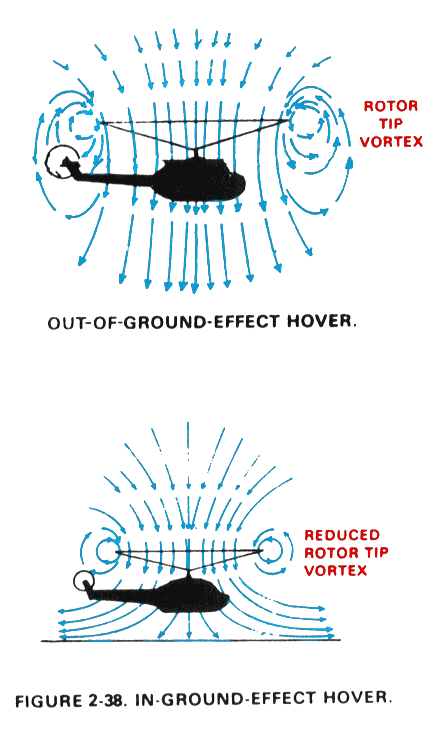

When operating in ground effect, the downward and outward airflow pattern tends to restrict vortex generation. This makes the outboard portion of the rotor blade more efficient and reduces overall system turbulence caused by ingestion and recirculation of the vortex swirls.
Rotor efficiency is increased by ground effect up to a height of about one rotor diameter for most helicopters. This figure illustrates the percent increase in rotor thrust experienced at various rotor heights: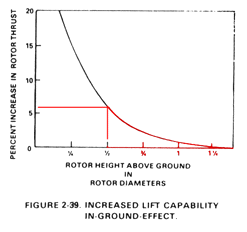
At a rotor height of one-half rotor diameter, the thrust is increased about 7 percent. At rotor heights above one rotor diameter, the thrust increase is small and decreases to zero at a height of about 1 1/4 rotor diameters.
Maximum ground effect is accomplished when hovering over smooth paved surfaces. While hovering over tall grass, rough terrain, revetments, or water, ground effect may be seriously reduced. This phenomena is due to the partial breakdown and cancellation of ground effect and the return of large vortex patterns with increased downwash angles.
Two identical airfoils with equal blade pitch angles are compared in the following figure: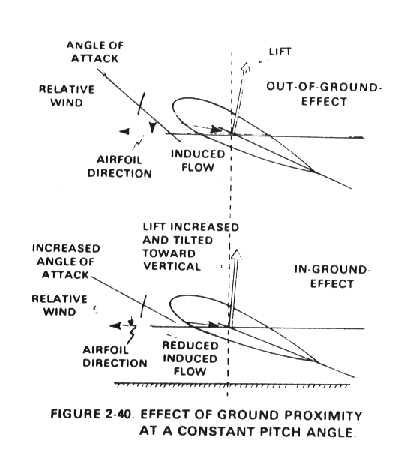
The top airfoil is out-of-ground-effect while the bottom airfoil is in-ground-effect. The airfoil that is in-ground-effect is more efficient because it operates at a larger angle of attack and produces a more vertical lift vector. Its increased efficiency results from a smaller downward induced wind velocity which increases angle of attack. The airfoil operating out-of-ground-effect is less efficient because of increased induced wind velocity which reduces angle of attack.
If a helicopter hovering out-of-ground-effect descends into a ground-effect hover, blade efficiency increases because of the more favorable induced flow. As efficiency of the rotor system increases, the pilot reduces blade pitch angle to remain in the ground-effect hover. Less power is required to maintain however in-ground-effect than for the out-of-ground-effect hover. -
Infomative!
-
Torque
In accordance with Newton's law of action and reaction, the helicopter fuselage tends to rotate in the direction opposite to the rotor blades. This effect is called torque. Torque must be counteracted and or controlled before flight is possible. In tandem rotor and coaxial helicopter designs, the rotors turn in opposite directions to neutralize or eliminate torque effects. In tip-jet helicopters, power originates at the blade tip and equal and opposite reaction is against the air; there is no torque between the rotor and the fuselage. However, the torque problem is especially important in single main rotor helicopters with a fuselage mounted power source. The torque effect on the fuselage is a direct result of the work/resistance of the main rotor. Therefore torque is at the geometric center of the main rotor. Torque results from the rotor being driven by the engine power output. Any change in engine power output brings about a corresponding change in torque effect. Furthermore, power varies with the flight maneuver and results in a variable torque effect that must be continually corrected.
Antitorque Rotor (Will show more on this further down)
Compensation for torque in the single main rotor helicopter is accomplished by means of a variable pitch antitorque rotor (tail rotor) located on the end of a tail boom extension at the rear of the fuselage. Driven by the main rotor at a constant ratio, the tail rotor produces thrust in a horizontal plane opposite to torque reaction developed by the main rotor. Since torque effect varies during flight when power changes are made, it is necessary to vary the thrust of the tail rotor. Antitorque pedals enable the pilot to compensate for torque variance. A significant part of the engine power is required to drive the tail rotor, especially during operations when maximum power is used. From 5 to 30 percent of the available engine power may be needed to drive the tail rotor depending on helicopter size and design. Normally, larger helicopters use a higher percent of engine power to counteract torque than do smaller aircraft. A helicopter with 9,500 horsepower might require 1,200 horsepower to drive the tail rotor, while a 200 horsepower aircraft might require only 10 horsepower for torque correction.
Heading Control
In addition to counteracting torque, the tail rotor and its control linkage also permit control of the helicopter heading during flight. Application of more control than is necessary to counteract torque will cause the nose of the helicopter to swing in the direction of pedal movement. To maintain a constant heading at a hover or during takeoff or approach, the pilot must use antitorque pedals to apply just enough pitch on the tail rotor to neutralize torque and hold a slip if necessary. Heading control in forward trimmed flight is normally accomplished with cyclic control, using a coordinated bank and turn to the desired heading. Application of antitorque pedals will be required when power changes are made.
In an autorotation, some degree of right pedal is required to maintain correct trim. When torque is not present, mast thrust bearing friction tends to turn the fuselage in the same direction as main rotor rotation. To counteract this friction, the tail rotor thrust is applied in an opposite direction to counter the frictional forces.
Translating tendency
During hovering flight, the single rotor helicopter has a tendency to drift laterally to the right due to the lateral thrust being supplied by the tail rotor. The pilot may prevent right lateral drift of the helicopter by tilting the main rotor disk to the left. This lateral tilt results in a main rotor force to the left that compensates for the tail rotor thrust to the right.
Helicopter design usually includes one or more features which help the pilot compensate for translating tendency.
- Flight control rigging may be designed so the rotor disk is tilted slightly left when the cyclic control is centered.
- The collective pitch control system may be designed so that the rotor disk tilts slightly left as collective pitch is increased to hover the aircraft.
- The main transmission may be mounted so that the mast is tilted slightly to the left when the helicopter fuselage is laterally level. -
Flapping
Flapping can be pretty hard to understand at first, although it really is a fairly simple concept. A couple things you need to understand is the relationship between angle of attack and relative wind. Relative wind is simply the direction the air seems to be coming at you because of your motion. When you stick your hand out of a moving car window, the wind hitting it seems to be coming from directly in front of you. The wind will always seem to be moving in the opposite direction of your motion. For instance, in the car example, the car is moving forward, and the wind seems to be moving backward.
Now lets change the example a little bit. Take a hardcover book in your hand, and drop it. Think about a little person glued to the bottom of the book. As the book falls, he will feel the wind seem to come directly up at him from the ground. Again, this is relative wind due to the motion of the book: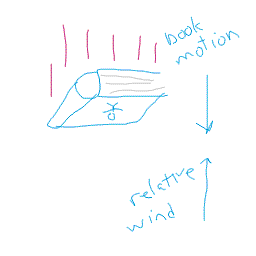
Instead of dropping the book, let's slide it along a table sideways. The table is there to prevent it from falling, so the only motion will be sideways motion. For this exercise, we let the little guy stand on top so he won't be squished: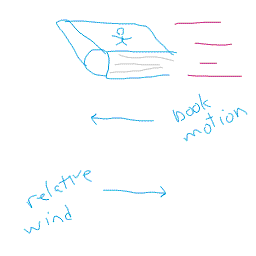
What if we remove the table, throw the book sideways, allowing it to also fall toward the ground. It will have two components of motion, one horizontal and one vertical, like this: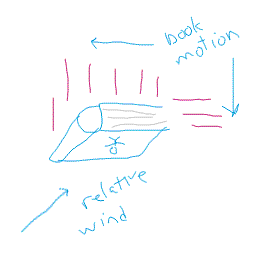
Note that the relative wind is the combination of the horizontal and vertical motions. To the poor little guy about to be squished again, it seems to be coming at him from an angle, somewhere between the vertical and horizontal. Now let's use a tiny bit of math. If we draw the blue arrows to represent the two components of motion, horizontal and vertical, and then we extend red lines down from the top arrowhead and to the left from the bottom arrowhead until they meet, we can then draw the green line back to the origin of the two vectors. The green line is a vector which will show us the direction the relative wind is coming at the little guy on the book: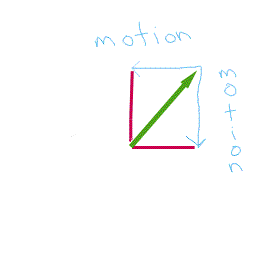
Notice that the two blue lines are about the same length, and that the angle ends up being about 45 degrees. That's not by chance. Let's take a look at what happens if we make the horizontal component of motion be twice as fast as the vertical component: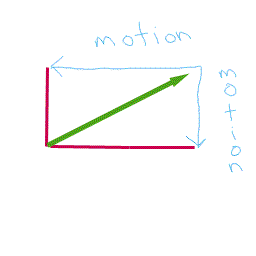
Notice how the angle has changed! Because the horizontal component is larger, the angle seems to be more horizontal than vertical. We can calculate the angle this way, as long as we know the horizontal component and vertical component of motion.
Okay, what's all this got to do with flapping? If it's not already obvious, the book represents the rotor blade. Let's see a picture of a rotor blade that is spinning, but not flapping: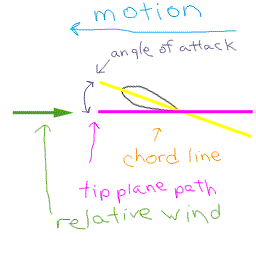
This is sort of a complex diagram, but lets take it part by part. The blue line shows the motion of the rotor blade, moving forward due to rotation. The green line shows the relative wind. Since there is only a horizontal component to motion right now, the green line is horizontal. The pink line labeled tip plane path shows the orientation of the rotor disk. It's just another line showing the horizontal motion of the rotor blade. The yellow line which is labeled chord line can just be thought of the direction the airfoil is facing (but not necessarilly moving). In the case of this diagram, this would all be consistent with a helicopter at hover: the chord line is tilted because the pilot has raised the collective control, thereby tilting the blade up from the horizontal. Angle of attack is defined as the angle between the relative wind and the chord line. That is shown by the purple line.
In the next figure, we've added some vertical motion to the rotor blade: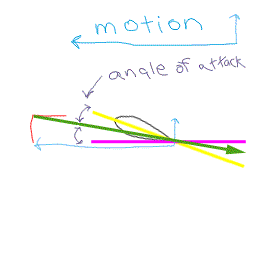
The way I've drawn this is on top to show the two components of motion of the rotor blade. Note that the blade is flapping up. I've copied the blue lines of motion down by the airfoil, and used the red lines to show where we would extend the blue lines to. Then I drew the green relative wind line from this point back to the origin. There are a few interesting things to notice now.
First of all, remember that the relative wind is equal and opposite to the direction the object is going, so the green relative wind line also gives us an idea of the path of the blade. Clearly it is moving forward and up. The important thing to notice, however, is that the angle between the relative wind and the chord line is now cut about in half. In this case, the lift would also be cut in half. If this is not clear to you, lets see the same diagram, but rotated so that the relative wind is horizontal to us: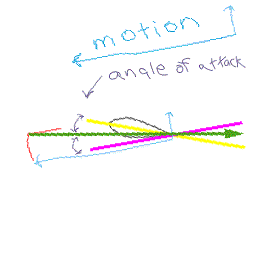
It should be clear that the angle of attack in this picture is much smaller than the diagram without flapping.
One final key to all this is, what makes the blade flap up? The answer is very simple: it's the excess lift. Remember that at a hover, the blade angle is where the forces of lift and centrifugal force balance out. If we increase the lift (because of the excess airspeed on the advancing blade) and the centrifugal force stays the same, the extra lift will cause the blade to flap up to a higher position until lift and centrifugal forces are once again in balance. -
Aerodynamics of Autorotation
During powered flight, the rotor drag is overcome with engine power. When the engine fails, or is deliberately disengaged from the rotor system, some other force must be used to sustain rotor RPM so controlled flight can be continued to the ground. This force is generated by adjusting the collective pitch to allow a controlled descent. Airflow during helicopter descent provides the energy to overcome blade drag and turn the rotor. When the helicopter is descending in this manner, it is said to be in a state of autorotation. In effect the pilot gives up altitude at a controlled rate in return for energy to turn the rotor at an RPM which provides aircraft control. Stated another way, the helicopter has potential energy by virtue of its altitude. As altitude decreases, potential energy is converted to kinetic energy and stored in the turning rotor. The pilot uses this kinetic energy to cushion the touchdown when near the ground.
Most autorotations are performed with forward airspeed. For simplicity, the following aerodynamic explanation is based on a vertical autorotative descent (no forward airspeed) in still air. Under these conditions, the forces that cause the blades to turn are similar for all blades regardless of their position in the plane of rotation. Dissymmetry of lift resulting from helicopter airspeed is therefore not a factor, but will be discussed later.
During vertical autorotation, the rotor disk is divided into three regions: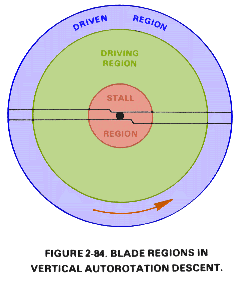
- The driven region, also called the propeller region, is nearest to the blade tips and normally consists of about 30 percent of the radius. The total aerodynamic force in this region is inclined slightly behind the rotating axis. This results in a drag force which tends to slow the rotation fo the blade.
- The driving region or autorotative region, normally lies between about 25 to 70 percent of the blade radius. Total aerodynamic force in this region is inclined slightly forward of the axis of rotation. This inclination supplies thrust which tends to accelerate the rotation of the blade.
- The stall region includes the inboard 25 percent of the blade radius. It operates above the stall angle of attack and causes drag which tends to slow the rotation of the blade.
The following figure shows three blade sections that illustrate force vectors in the driven region "A", a region of equilibrium "B" and the driving region "C":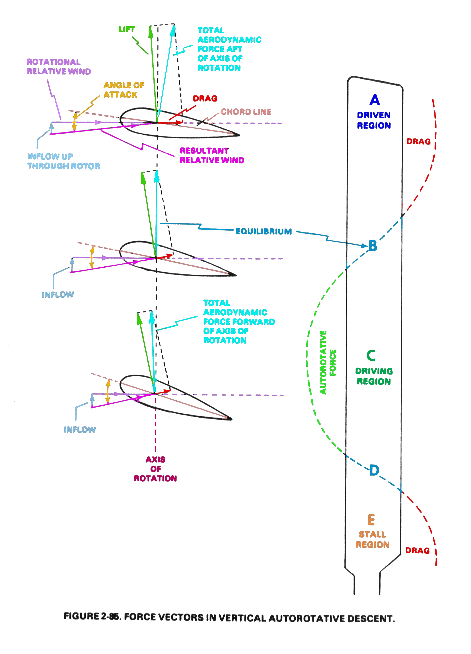
The force vectors are different in each region, because the rotational relative wind is slower near the blade root and increases continually toward the blade tip. When the inflow up through the rotor combines with rotational relative wind, it produces different combinations of aerodynamic force at every point along the blade.
In the driven region, the total aerodynamic force acts behind the axis of rotation, resulting in an overall dragging force. This area produces lift but it also opposes rotation and continually tends to decelerate the blade. The size of this region varies with blade pitch setting, rate of descent, and rotor RPM. When the pilot takes action to change autorotative RPM, blade pitch, or rate of descent, he is in effect changing the size of the driven region in relation to the other regions.
Between the driven region and the driving region is a point of equilibrium. At this point on the blade, total aerodynamic force is aligned with the axis of rotation. Lift and drag are produced, but the total effect produces neither acceleration nor deceleration of the rotor RPM. Point "D" is also an area of equilibrium in regard to thrust and drag.
Area "C" is the driving region of the blade and produces the forces needed to turn the blades during autorotation. Total aerodynamic force in the driving region is inclined forward of the axis of rotation and produces a continual acceleration force. Driving region size varies with blade pitch setting, rate of descent and rotor RPM. The pilot controls the size of this region in relation to the driven and stall regions in order to adjust autorotative RPM. For example, if the collective pitch stick is raised, the pitch angle will increase in all regions. This causes the point of equilibrium "B" to move toward the blade tip, decreasing the size of the driven region. The entire driving region also moves toward the blade tip. The stall region becomes larger and the total blade drag is increased, causing RPM decrease.
A constant rotor RPM is achieved by adjusting the collective pitch control so blade acceleration forces from the driving region are balanced with the deceleration forces from the driven and stall regions.
Aerodynamics of autorotation in forward flight
Autorotative force in forward flight is produced in exactly the same manner as when the helicopter is descending vertically in still air. However, because forward speed changes the inflow of air up through the rotor disk, the driving region and stall region move toward the retreating side of the disk where angle of attack is larger: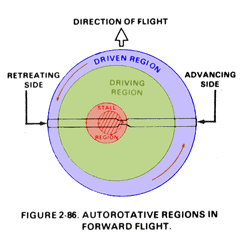
Because of lower angles of attack on the advancing side blade, more of that blade falls into the driven region. On the retreating side blade, more of the blade is in the stall region, and a small section near the root experiences a reversed flow. The size of the driven region on the retreating side is reduced.
Autorotations may be divided into three distinct phases; the entry, the steady state descent, and the deceleration and touchdown. Each of these phases is aerodynamically different than the others. The following discussion describes forces pertinent to each phase.
Entry into autorotation is performed following loss of engine power. Immediate indications of power loss are rotor RPM decay and an out-of-trim condition. Rate of RPM decay is most rapid when the helicopter is at high collective pitch settings. In most helicopters it takes only seconds for the RPM decay to reach a minimum safe range. Pilots must react quickly and initiate a reduction in collective pitch that will prevent excessive RPM decay. A cyclic flare will help prevent excessive decay if the failure occurs at thigh speed. This technique varies with the model helicopter. Pilots should consult and follow the appropriate aircraft Operator's Manual. -
The following figure shows the airflow and force vectors for a blade in powered flight at high speed:
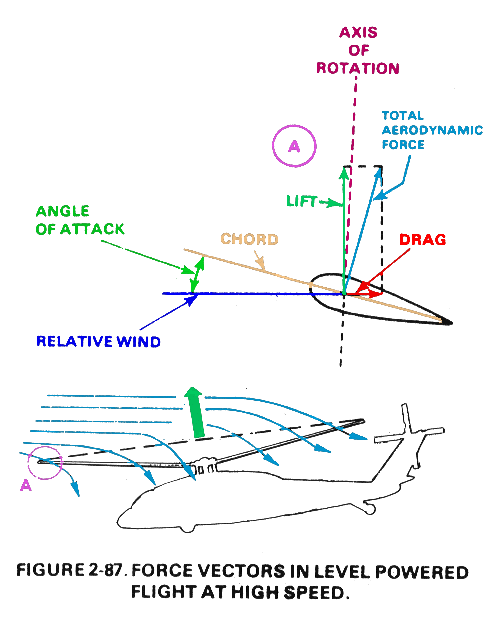
Note that the lift and drag vectors are large and the total aerodynamic force is inclined well to the rear of the axis of rotation. If the engine stops when the helicopter is in this condition, rotor RPM decay is rapid. To prevent RPM decay, the pilot must promptly lower the collective pitch control to reduce drag and incline the total aerodynamic force vector forward so it is near the axis of rotation.
The following figure shows the airflow and force vectors for a helicopter just after power loss: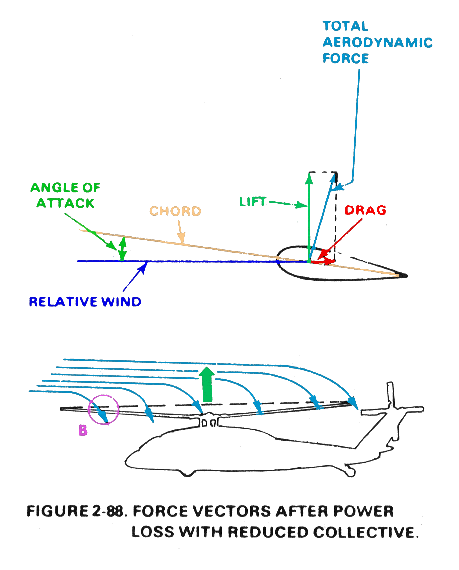
The collective pitch has been reduced, but the helicopter has not started to descend. Note that lift and drag are reduced and the total aerodynamic force vector is inclined further forward than it was in powered flight. As the helicopter begins to descend, the airflow changes. This causes the total aerodynamic force to incline further forward. It will reach an equilibrium that maintains a safe operating RPM. The pilot establishes a glide at the proper airspeed which is 50 to 75 knots, depending on the helicopter and its gross weight. Rotor RPM should be stabilized at autorotative RPM which is normally a few turns higher than normal operating RPM.
The following figure shows the helicopter in a steady state descent: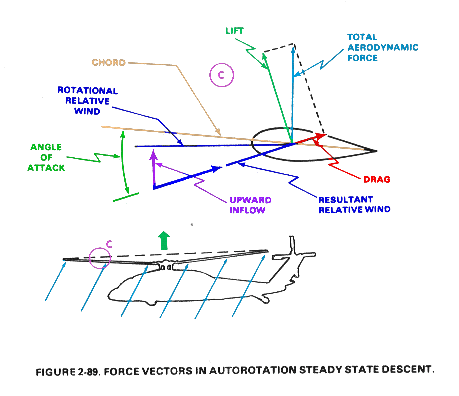
Airflow is now upward through the rotor disk due the descent. Changed airflow creates a larger angle of attack although blade pitch angle is the same as it was in the previous picture, before the descent began. Total aerodynamic force is increased and inclined forward so equilibrium is established. Rate of descent and RPM are stabilized, and the helicopter is descending at a constant angle. Angle of descent is normally 17 degrees to 20 degrees, depending on airspeed, density altitude, wind, the particular helicopter design, and other variables.
The following figure illustrates the aerodynamics of autorotative deceleration: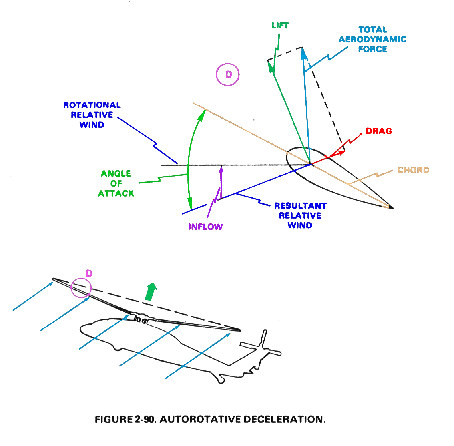
To successfully perform an autorotative landing, the pilot must reduce airspeed and rate of descent just before touchdown. Both of these actions can be partially accomplished by moving the cyclic control to the rear and changing the attitude of the rotor disk with relation to the relative wind. The attitude change inclines the total force of the rotor disk to the rear and slows forward speed. It also increases angle of attack on all blades by changing the inflow of air. As a result, total rotor lifting force is increased and rate of descent is reduced. RPM also increases when the total aerodynamic force vector is lengthened, thereby increasing blade kinetic energy available to cushion the touchdown. After forward speed is reduced to a safe landing speed, the helicopter is placed in a landing attitude as collective pitch is applied to cushion the touchdown -
hahaha... interesting.
kopi>have u seen the coning thingy... think I saw it in Oz exercise.. almost Max all up weight... the blades bend so much upwards.. look so scary..hahaha....
good thing is I'm not in that aircraft
-
Helicopter Tail Rotors
The problem with Torque
One of the very first problems helicopter designers encountered when they tried to create a machine that could hover was the problem of torque reaction. Newton's third law of motion requires that for every action there is an equal and opposite action. A typical single main rotor helicopter has a rotor system mounted on a rotor mast. The helicopter engine supplies power so that the helicopter can turn the mast, and thus the rotor system connected to it. When the helicopter applies torque to the mast to spin it, there is an equal-and-opposite torque reaction which tries to turn the helicopter in the opposite direction.
Eliminating the torque reaction
Counter Rotating Rotors
Most of the early designers seemed to use multiple rotors spinning in opposite directions as a way to cancel the torque. The advantage of these types of systems (co-axial, tandem, intermeshing) are that the torque is countered with no loss of power. When 50% of the torque is used to turn one rotor clockwise, and 50% of the torque is used to turn a second rotor counter-clockwise, the torque reactions balance out. 100% of the engine power goes into turning the lifting rotor systems.
There are still several production helicopters which use multiple counterrotating rotors as a way to cancel out torque. Examples are the Boeing-Vertol tandem rotor helicopters which evolved from Frank Piaseki's designs, Charles Kaman's intermeshing rotor system, and the Russian co-axial helicopter (Hocum or Havoc I think it is, I'll have to look up the correct name I'm afraid). The V22 tilt-rotor uses counter-rotating proprotors in order to cancel out torque. It is similar to a tandem rotor system when in helicopter mode.
Tail Rotors
Igor Sikorsky seems to be the first to settle on using a single rotor mounted at the rear of the helicopter as a way to counter the torque. This is the most popular arrangement today. Sikorsky actually experimented with many different arragements before selecting a single tail mounted rotor.
It seems strange that the majority of helicopters produced use this method of countering torque, given that there are several major problems with this method which are not encountered with counter-rotating rotor systems.
One major problem with tail rotors is that they rob an enormous amount of power. As a rule of thumb, tail rotors consume up to 30% of the engine power.
Another probem is that due to size and weight constraints, tail rotors are fairly delicate compared to main rotors. This means that they cannot survive an encounter with very large obstacles. Because they are mounted at the rear of the helicopter, out of the pilot's sight, a fairly common cause of helicopter accidents is hitting an obstacle with the tail rotor, losing all anti-torque capability, and crashing due to the rotation of the entire helicopter.
Still another problem with tail rotors is that they are fairly difficult to control accurately. Turbulence and crosswinds make it extremly difficult to hold a constant heading in a tail rotor equipped helicopter. The workload is very high, and good results are difficult to achieve. Many larger helicopters end up being designed with a yaw stabalization system, which is essentially an autopilot for the tail rotor.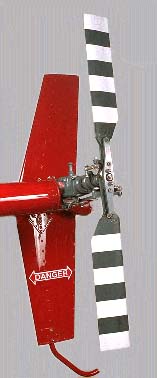
Tail Rotor Aerodynamics
Tail rotors share many of the aerodynamics of the helicopter main rotor system. They are essentially identical to a main rotor which is mounted sideways and is controllable in collective pitch, but is not capable of cyclic feathering. Some of the same problems which designers encountered with main rotors occur with tail rotors. Often the solution is similar or identical to the solution used on a main rotor.
Tail Rotor Dissymetry of Lift
Tail rotors experience dissymetry of lift just as a main rotor system does. (tail rotor dissymetry of lift is discussed specifically in in the dissymetry of lift aerodynamics section). This lift dissymetry would cause a torque around the tail boom which would tend to roll the fuselage in the same direction as main rotor lift dissymetry. While cyclic pitch could be used to counter the rolling tendancy, the tail rotor blades are typically allowed to flap, eliminating the lift dissymetry. Here is a picture of a Bell 206 JetRanger tail rotor flapped to right and left extremes: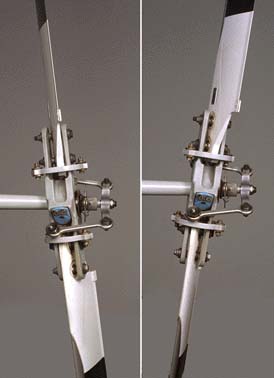
Tail Rotor Translational Lift
Just as a main rotor produces more lift when it moves into clean air, a tail rotor develops extra thrust when the helicopter moves it into clean air. Unfortunately, the pilot sees this as a change in anti-torque force which results in an uncommanded yaw of the aircraft. The pilot is forced to make an adjustment to his anti-torque pedals as the tail rotor goes in and out of translational lift.
There is no aerodynamic solution to this problem, and this is just one of the items which makes a tail rotor helicopter more difficult to fly. One solution which is sometimes used is a yaw-damper, essentially an auto-pilot which uses a gyroscope to detect uncommanded yaw, and which changes tail rotor pitch in order to prevent uncommanded yaw.
Tail Rotor Settling with Power
Just as a main rotor can get into a Ring Vortex State by settling into it's downwash, yawing the helicopter such that the tail rotor settles into it's downwash (sidewash?) can induce the same ring vortex state. Indeed, a crosswind can induce the ring vortex state without any yaw being present. While this may seem unlikely, I personally know someone who crashed a helicopter as a result of this.
The solution to this problem is similar to that for the main rotor: try to prevent it from happening, but if it does either move the tail rotor into clean air (by moving the helicopter), autorotate (to eliminate the torque) or try to get out of the ring vortex state by a very rapid and large increase in thrust (but if the pedal is already at the stop, this probably isn't possible). A hover auto is probably the safest, most reliable way to get out of this situation.
Tail Rotor Coning
While some tail rotors may be designed to allow coning, all tail rotors that I am familiar with simply pre-cone the blades and don't worry about coning in the design. Helicopters with more than 2 blades (or more than 2 double stacked blades like the Hughes/MDHC-500) probably have a flapping hinge which acts as a coning hinge. I'll have to ask my friends at Sikorsky as they tend to build helicopters with large numbers of blades. -
coning happens everytime it flies...Originally posted by X-men:hahaha... interesting.
kopi>have u seen the coning thingy... think I saw it in Oz exercise.. almost Max all up weight... the blades bend so much upwards.. look so scary..hahaha....
good thing is I'm not in that aircraft
but i've never seen the pumas go to its max coning angle leh...
was it carrying anything during the exercise? -
Changing the Pitch
In order to be able to yaw the aircraft both right or left, the tail rotor blades need to be able to be set to both negative and positive angles of attack, unlike main rotors which are normally only capable of positive angles of attack.
The angle of attack of the tail rotor is controlled by the pilot's anti-torque pedals (they're not "rudder pedals" in a helicopter). The pedals are typically connected to the pitch change mechanism by either push pull tubes, or by cables. From the standpoint of controlling pitch, a tail rotor requires collective pitch control, but not cyclic feathering. This makes the pitch control mechanism of most tail rotors much simpler than that of the main rotor system.
The tail rotor blades must be mounted, and there must be a mechanism to change the pitch of the blades. This picture is of a Robinson R22 tail rotor. You can clearly see how the blades are attached, and how the pitch change mechanism can pivot the blades.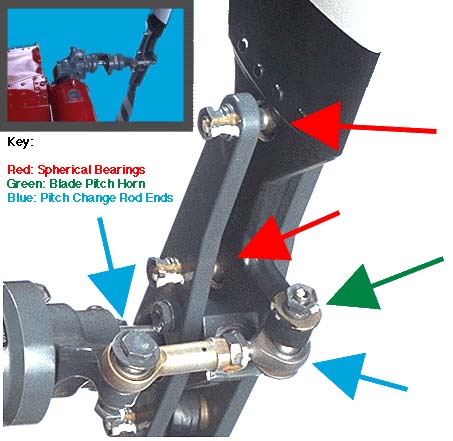
The red arrows point at the attach points for the blade itself. These attach points are a bolt which goes from one side of the yoke, through the blade, and into the other side of the yoke. The spherical bearing itself allows the blade complete freedom to rotate around the ball, which the upper red arrow is pointing at. Because there are two of these spherical bearings (you can just see the second one that the lower red arrow is pointing at) the blade is constrained to only move around an axis which is aligned between the two bearings. This allows the blade's pitch (angle of attack) to be changed, but allows no other motion of the blade with respect to the yoke.
Notice that the bottom of the blade makes an "L" shape, with the green arrow pointing to the end of the "L" where a bolt goes through it. The "L" part of the blade, which I call a "Pitch horn", gives us some leverage to move the blade in pitch.
The bolt which goes through the "pitch horn" also goes through a pitch change rod end (right hand blue arrow) which has one of those spherical bearings in it. This allows the rod end to push and pull on the pitch horn, thereby changing the pitch of the blade.
The other end of the rod end (left side blue arrow) is attached to the pitch change yoke. This is examined in a later picture. Here is another picture of the same assembly, from a very slightly different angle. You can see the "L" shaped bottom of the blade better, and it's a little more obvious how it attaches to the pitch change rod.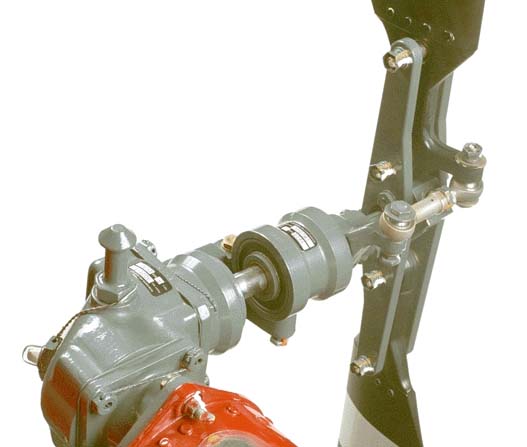
Here is the same assembly, except that now we are standing behind the helicopter looking directly forward at the tail rotor assembly:
This picture shows how the pitch change mechanism works: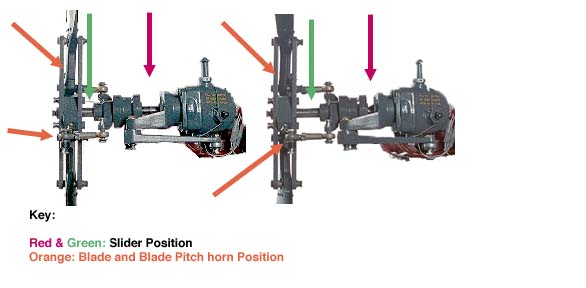
The red and green arrows show how the slider slides left and right on the shaft. The pitch change rods are connected to the slider, and so as the slider moves to the right, the pitch change rods move to the right, and take the blade pitch horn with them. If you look carefully at the bottom orange arrows, you can see that the pitch change rod and the blade pitch horn have been moved to the right. The upper orange arrow just points at the blade, which you can see is at a different pitch angle in the two pictures.
Here is the Bell 206 JetRanger tail rotor. Notice that the pitch change mechanism is quite different than the R22. The pitch change rod is actually a shaft which goes through the hollow shaft the tail rotor is mounted on: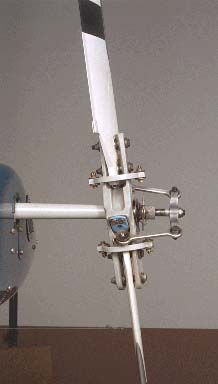
Here is a closeup of the tail rotor hub at two extreme pitch settings. In the left hand picture, the red arrow shows that the inner shaft has been extended all the way to the right. The right hand picture shows the same shaft has been retracted: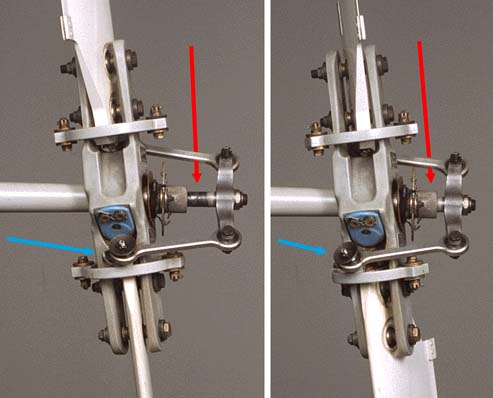
As the inner shaft slides left and right, the pitch change rods are dragged along, and pulls the blade pitch change horn along with it. The blue arrow points out how far the rod end has moved, taking the blade's leading edge with it. Like the Robinson, the blade is mounted on two spherical bearings, which cause it to rotate only in the pitch axis.
This is the Enstrom F28A tail rotor assembly. In the lower left corner of the picture, you can see the cable attaching to the pitch change mechanism. The Enstrom blades don't attach with spherical bearings the way the Robinson and Bell do, they utilize a bearing pack to allow the blade to feather.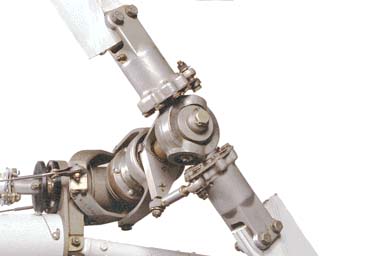
-
underslung... dont knw what liao.. some vehicle I think.Originally posted by kopiosatu:coning happens everytime it flies...
but i've never seen the pumas go to its max coning angle leh...
was it carrying anything during the exercise?
usually the coning is not very obvious mah...that time one can really see the diff leh... -
that means the load must be pretty heavy!!!Originally posted by X-men:underslung... dont knw what liao.. some vehicle I think.
usually the coning is not very obvious mah...that time one can really see the diff leh... -
Cyclic Control
The cyclic is used to tip the rotor disk, and thus move the helicopter either forward, backward, or sideways. Here is an Enstrom F28A cyclic: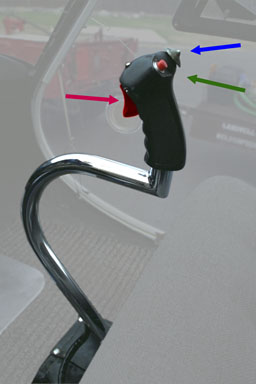
The arrows are pointing to 3 controls on the F28 cyclic.
The red arrow on the left is pointing at the trigger switch. This is used for transmitting on the radio. Normally, the first click would activate the intercom so the pilot could talk to the other people on board the helicopter, and the second click (i.e. all the way in) would actually transmit on the radio. In our F28, the first click doesn't do anything because we have a voice activated intercom, and so the switch isn't required.
On the right side, the upper arrow which is blue points at the trim switch. This is called a "coolie hat" because it has a shape similar to that of an asian peasant's hat. It is like a joystick, and can be moved up, down, left and right. The pilot uses this to neutralize stick force. If air loads from the rotor system are holding the cyclic to the left, the pilot can push the trim switch to the right. This runs an electric motor which will tension a spring which will tend to hold the stick to the right. If the pilot uses the trim correctly, the cyclic will stay where it is even if the pilot were to let go. Everytime the airspeed is changed, or a different cross wind is encountered, the pilot must retrim to remove the stick forces.
The bottom arrow on the right side points to the cargo release switch. This could be used for other things if no cargo hook is installed. We don't have a cargo hook on this helicopter, but we haven't bothered to hook this button to anything else, so it doesn't do anything for us. If this was connected to a cargo release hook, pushing this button would cause an external load suspended beneath the helicopter on a cable to be released from the hook.
The curve in the cyclic allows it to move back quite a few inches before it hits the seat, yet the handle is right where it is comfortable for the pilot to reach.
Compare the Robinson R22 Cyclic, which is a radically different design than most other cyclics: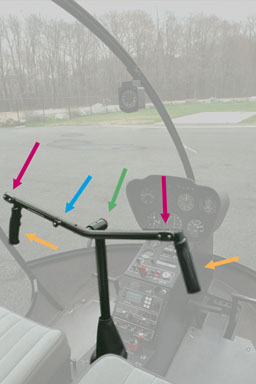
There are a few things to note, which is why there are so many arrows! The orange arrows point to the hand grips. The green arrow points to the pivot point for the cyclic. The hand grips can be teetered up and down around this pivot, like a see saw. If one hand grip goes up, the other has to go down, they can't move independently.
The blue arrow points to the pin which allows the left hand grip assembly to be removed. (The left hand collective and pedals can also be removed).
The red arrows point to each set of intercom and transmit buttons. Unlike the Enstrom, the Robinson R22s do not normally have a voice activated intercom. You have to push your intercom button in order to speak to the other person in the helicopter. On the left hand floor, there is a foot switch which allows the person in the left hand to either use the cyclic or floor mounted switch to activate the intercom. The foot switch allows use of the intercom when the left hand grip is removed from the cyclic. It is also used by instructors sitting on the left side, so that they can talk to the pilot receiving instruction without the instructor having to push on the cyclic.
The second switch on each side of the cyclic is the radio transmit button. When the left hand cyclic assembly is removed, there is no way for the person in the left hand seat to transmit on the radio.
Most people react negatively to the Robinson style cyclic at first. However, as you get used to it, you realize that there are several advantages to this arrangement. Personally, I like having the column coming up from the floor where it is, away from hitting my legs. I just wish that each hand grip could move up and down independently so that each pilot could set the hand grip height to a comfortable position. As it is, instructors end up learning to fly with their arm high in the air so that the student pilot can rest his arm on his leg. -
Collective Control
The collective is used to increase main rotor pitch simultaneously at all points of the rotor blade rotation. It increases or decreases total rotor thrust, whereas the cyclic changes rotor thrust direction. In a hover, changes in collective pitch will result in a different height above the ground. In forward flight, changes in collective pitch change the amount of thrust available, which can result in either a change in altitude or speed depending on how the pilot moves the cyclic.
Robinson R22 Collective
The yellow arrow on the right points to the twist grip throttle control. This works like a motorcycle twist grip. The Robinson R22 incorporates a throttle correlator which automatically rolls some throttle on and off as the collective is raised and lowered. The pilot does not feel the twist grip move, as the correlator is connected later on in the linkage.
The Robinson R22 offers an optional RPM governor. When this is installed, the pilot will feel the throttle roll on and off as the governor attempts to maintain RPM. Not all R22s have governors, although some of us suspect that an AD (Airworthiness Directive) from the FAA may soon make them mandatory on all R22s. There are two types of governors available on R22s. The old style governor will both roll throttle on and off and move the collective in order to maintain RPM. The new style governor was originally designed for the R44, but is now being installed on R22s as well. This governor uses throttle, but not collective, to maintain RPM. It is extremely effective.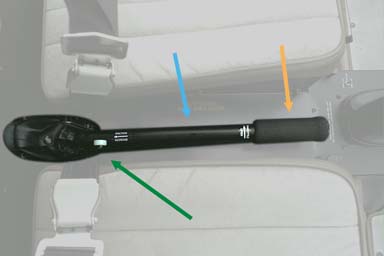
The blue arrow points to the collective lever (which the throttle twist grip is mounted on). The collective lever is connected to the swash plate by a series of push-pull tubes. Raising the collective lever increases the pitch on the main rotor blades, lowering the collective lever decreases the main rotor blade pitch.
The green arrow on the left points to the collective friction control. This control allows the pilot to control the amount of force it takes to move the collective control. The friction can be used on the ground and in flight in the Robinson helicopters.
Enstrom F28A Collective
The dark blue arrow points at the twist grip throttle control. In addition, the F28 incorporates throttle friction, which is the knurled knob pointed to by the light blue arrow. This control allows you to adjust the amount of force it takes to twist the throttle.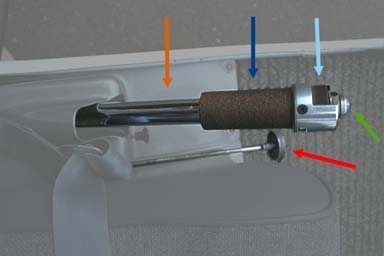
The orange arrow points to the collective lever, which works identically to the collective lever on the Robinson.
The red arrow points to the collective friction knob. Unlike the Robinson, Enstrom does not allow you to use collective friction in flight. The control is provided because during startup and shutdown the collective has a tendance to raise to the up position all on it's own. The friction is used to hold the collective down during these times.
The green arrow points to the starter button, which is on the end of the collective. This allows the pilot to activate the engine starter motor without having to take his hand off the collective. If the engine stalls during flight, he can enter autorotation while simultaneously cranking the engine to attempt to restart it. Contrast that with the Robinson which requires you to take your hand off the collective to crank with the key switch. The Enstrom only provides the starter on the left hand collective.
Bell 206BIII JetRanger Collective
Starting from the left, the orange arrow point at the collective lever. The collective lever is connected to the rotor system via push pull tubes. The 206 also has a droop compensation device which senses changes in the collective pitch lever and increases or decreases fuel to the engine somewhat in anticipation of a change in power required. This helps to minimize the RPM fluctuations during collective pitch change.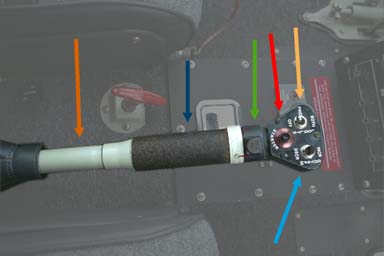
The dark blue arrow points to the throttle twist grip. This performs the function of an engine condition control, with positions for off, idle, and flight. In the flight position the throttle is rolled full open, and the fuel control (governor) controls the amount of fuel going to the engine in order to maintain proper rotor RPM. Between the flight and idle positions, the throttle can be used as a manual throttle, although this would only be done during an emergency (or simulated emergency) condition. This is useful during any event which would cause engine or rotor RPM to go too high, such as a high side governor failure or short shaft failure. The throttle can be rolled off to limit the amount of fuel going to the engine so that RPM is maintained in the green operating arc. Another time when this is useful is while landing after a tail rotor failure. The throttle can be manipulated to produce the amount of torque required to line the landing gear up with ground track during a running landing. The throttle can not be used to increase fuel flow over what the governor is commanding, which means it can not be used as a manual fuel control to correct for a low side governor failure.
The green arrow is pointing to the idle release button. When the throttle is rolled from "off" to "idle", the idle release button snaps into a detent which prevents the throttle from being rolled back to "off". This prevents the pilot from flaming out the engine when going from "flight" to "idle". In order to move the throttle from "idle" to "off", the pilot must hold down the idle release button while rolling the throttle to "off".
The red arrow is pointing at the starter button. Pushing this button causes the starter/generator to act as a starter motor, turning over the engine. The starter can also be used to motor the engine in order to cool it down by forcing cool air through it.
The yellow arrow points at the landing light switch, which is a three position switch. The three positions are "off", "forward" and "both". In forward, only the forward pointing light is activated. In "both", the forward and the downward angled lights are activated.
The blue arrow on the bottom points to the governor trim switch. By holding it in "increase" or "decrease" the pilot can set the RPM that the governor will attempt to maintain. -
Instrument Panels
Robinson R22 Instrument panel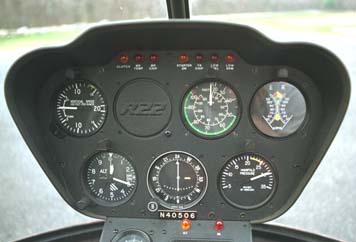
Enstrom F28A Instrument Panel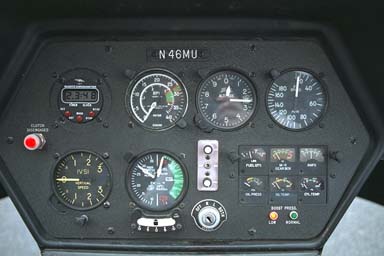
Bell 206BIII JetRanger Instrument Panel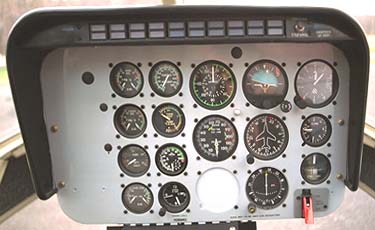
-
The panels, and flight controls look like toys compared to the SP

-
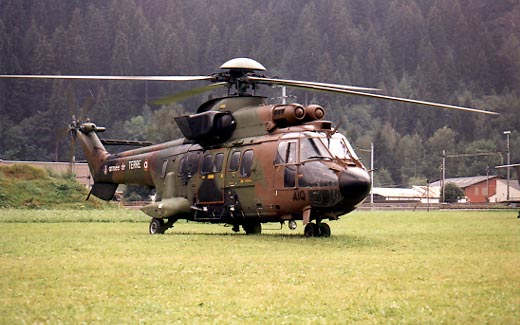
X-men, were u around when they had this mod? -
helis consume a lot of fuel?

-
all start from Mechanical Engineering

-
depends on the aircraft...Originally posted by poon cho tang:helis consume a lot of fuel?